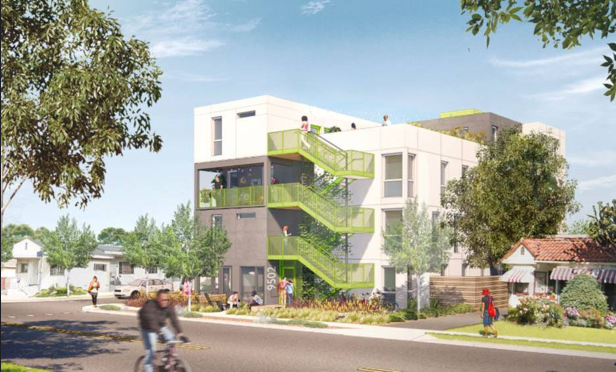 Design firm Studio One Eleven is building on its shipping container work with a new supportive housing project. Watts Works is a joint venture development from Decro Corp., Daylight Community Development and The People Concern, and features 24 studio apartments for low-income residents. It uses shipping containers for the four-story project and a modular-style construction, both of which drive down costs and boost efficiency.
Design firm Studio One Eleven is building on its shipping container work with a new supportive housing project. Watts Works is a joint venture development from Decro Corp., Daylight Community Development and The People Concern, and features 24 studio apartments for low-income residents. It uses shipping containers for the four-story project and a modular-style construction, both of which drive down costs and boost efficiency.
"Southern California desperately needs housing at all income levels. Due to the high costs of new housing, most projects coming on line are focused on the luxury market," Michael Bohn, senior principal at Studio One Eleven, tells GlobeSt.com. "Even affordable housing is becoming quite expensive to complete. We are intrigued with alternative construction methodologies as one approach to lower construction costs in order to help alleviate the affordability crisis. During site planning, we also look for alternatives from conventional methods that create greater value. In this case, steel modular containers work well with the site parameters, project scale and unit size, all of which expedite the construction schedule and reduce overall costs."
This specific site, located at 9502 S. Compton Avenue, of the project was also conducive to this style of construction. "As a design methodology, Studio One Eleven also studied the site and surrounding neighborhood to understand how to shape the building and corresponding garden spaces," says Bohn. "We located the majority of the building mass along 95th Street and used a roof garden to step the height down towards the adjacent neighbor along Compton Avenue. We also carved-out a side yard to save an existing heritage tree. This will help screen the building from the neighbors to the south, as well as preserve an asset for the neighborhood."
The project was funded through Measure HHH. The project secured $23.8 million in loans through the program to develop the project with this innovative set of materials. "The reaction has been overall positive," says Bohn. "Our developer was recently awarded $23.8 million in City of Los Angeles Measure HHH loans to continue this approach to building innovative, low-cost affordable housing. These funds will be used to create additional projects in other Los Angeles neighborhoods for a total of 132 units for homeless individuals."
Because the US imports more goods that it exports, there is currently a healthy supply of empty shipping containers, making it a good option for supportive housing. Each container costs approximately $3,000. Studio One Eleven has already used shipping containers for retail facilities. "We studied various construction methodologies, including site-built, wood and steel-stud modular," says Bohn. "However, due to the smaller scale of the development, both traditional wood construction and wood modular were not cost-effective. On the other hand, the tight site constraints, abundant service spaces, and small unit sizes created ideal conditions for shipping containers. We combined our extensive knowledge of shipping containers with Daylight's partnership with a manufacturing company experienced with containers, and that produced a significant cost savings per unit. For the building design, we utilized the site-built elements such as stairs and decks to bring scale and character to the rigid modular construction."
While shipping containers have the potential to solve a lot of development woes, Bohn doesn't expect a rush to the model. "There are certain limitations to the shipping-container module, so it is not a solution for everything. However, it is a viable option when certain parameters exist, as outlined earlier," he says. "Apart from housing, we have completed many successful, urban outdoor eating environments using containers. . And there's another design advantage: Because containers have become so visible on freeways, trains and at the ports, people have become used to them and even find them charming when artfully integrated with design."
© Touchpoint Markets, All Rights Reserved. Request academic re-use from www.copyright.com. All other uses, submit a request to [email protected]. For more inforrmation visit Asset & Logo Licensing.






